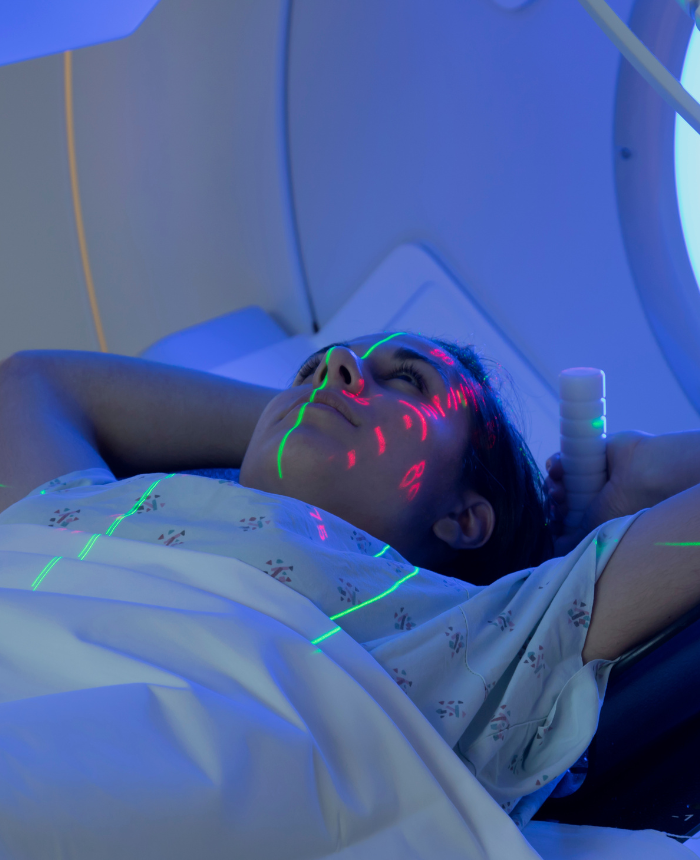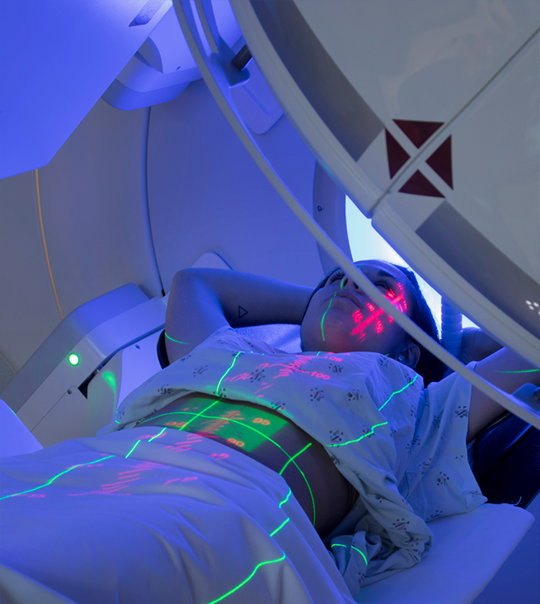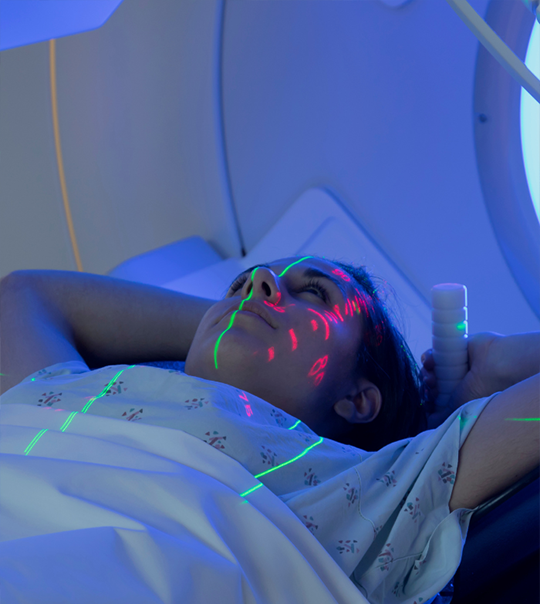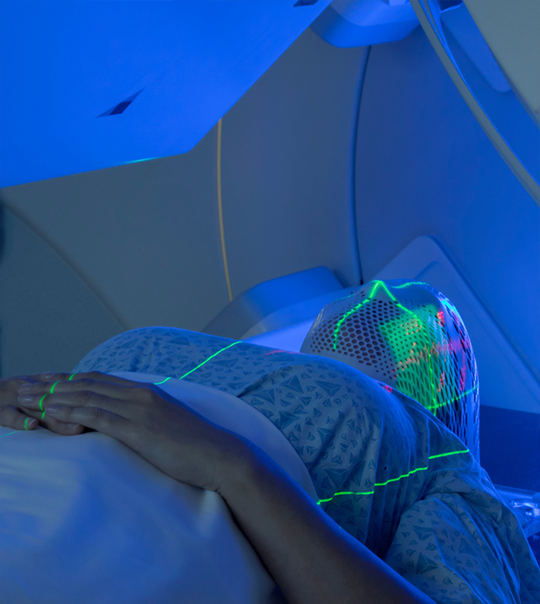
RADIATION TREATMENT
Intensity-modulated radiotherapy
(IMRT)
Intensity-modulated radiation therapy (IMRT) is an advanced form of external radiation treatment that allows highly focused targeting of tumor cells. It uses a linear accelerator with powerful energy beams to kill cancer cells.
The CT simulator localization scan or other 3-D images provide the radiation oncologist with an understanding of the shape and location of the tumor, increasing treatment accuracy.
With IMRT, your treatment team matches the radiation targeting and dose with the shape of your tumor. Rather than using one large beam, this treatment uses multiple smaller beams, which allows us to deliver a higher dose of radiation to the tumor itself while minimizing damage to nearby healthy tissue.
IMRT is often used to treat breast cancer, head and neck cancers, lung cancer, and prostate cancer. It may also be used to treat brain cancer, gastrointestinal cancers, lymphoma, sarcoma, gynecologic cancers, and some pediatric cancers and benign (non-cancerous) tumors.
What to expect during IMRT
IMRT typically requires multiple (fractionated) treatment sessions on different days. A typical IMRT treatment regimen is five days a week (Monday-Friday) for 2 to 9 weeks. Your doctor will consider the type, location, and size of your tumor, as well as your general health and the radiation doses to surrounding tissues, when they decide how many treatments you will receive.
Each IMRT session lasts 10-15 minutes. Once the treatment begins, it’s normal to hear the equipment moving, clicking, and buzzing. If you notice an unfamiliar smell, that’s normal, too—it’s just the ozone produced by our linear accelerator. The radiation treatment shouldn’t hurt, burn, or sting. If you get uncomfortable because of the position you’re in, let us know. The treatment can be paused to allow you to get more comfortable.
Ways to receive radiation
Radiation as a sole treatment modality
The type and stage of cancer, a patient's medical history, and more all go into the decision of whether and how to use radiation therapy. Radiation therapy can be used on its own to cure or treat early-stage cancer or to prevent a previous cancer from spreading to another area of the body. Radiation therapy may also be used to treat cancer that has spread too much to be cured, but for which some of the symptoms may be relieved. This is known as palliative radiation.
Radiation in combination with surgery
Physicians may recommend radiation prior to surgery to shrink the size of the tumor or when the location restricts surgical options. Radiotherapy can also be used during surgery (intraoperative radiation) to get straight to a cancer without passing through the skin. Patients may be advised to receive radiation after surgery to remove remaining cancer cells. Sometimes radiopharmaceutical therapies are also combined with radiation and surgery; for example, if you have metastatic prostate cancer, your treatment could include agents like radium 223 and Pluvicto, also known as lutetium 177.
Radiation with chemotherapy
When radiation is used in combination with chemotherapy, the treatment is called chemoradiation. Chemotherapy uses anti-cancer drugs to destroy cancer cells, and radiotherapy uses high-energy rays to destroy cancer cells. Chemotherapy can also be used as a radiosensitizer, enhancing the killing effect of radiation therapy on cancer cells.
Radiation to relieve symptoms
Radiation therapy may be recommended to relieve symptoms by reducing the size of the tumor and its effects on surrounding organs and tissues.
Radiation Therapy Resources
Here are some resources to help you better understand your treatment; how to prepare for treatment; and what to expect before, during, and after treatment occurs.
What Foods Should I Eat if Radiation Causes Nausea?
The best foods to eat if radiation causes nausea include those that are bland, easy to digest, and nutritionally dense. Read more to learn which foods to avoid.
Choosing the Right Radiation Oncology Center for You
You get to choose where to receive radiation therapy. But how do you know what the right choice is for you? Here are some top things to consider.
Recovering From Head and Neck Cancer
The recovery time for head and neck cancer varies by patient. Here, we share some of the top factors that can impact your recovery time.
Types of Radiation Therapy
Image-guided radiation therapy (IGRT)
IGRT combines 3-D images with 3D or intensity-modulated radiation therapy to pinpoint and treat cancerous tumors.

Intensity-modulated radiotherapy (IMRT)
IMRT is an advanced form of external radiation treatment that allows precise targeting of tumor cells.

Image-guided radiation therapy (IGRT)
IGRT combines 3-D images with 3D or intensity-modulated radiation therapy to pinpoint and treat cancerous tumors.

Intensity-modulated radiotherapy (IMRT)
IMRT is an advanced form of external radiation treatment that allows precise targeting of tumor cells.

Stereotactic body radiotherapy (SBRT)
SBRT is an advanced type of radiation therapy that delivers high doses of radiation aimed at a very targeted area of the body.

3-D conformal radiation therapy
3-D CRT uses technology to capture 3D representations of the tumor and surrounding organs.

Stereotactic body radiotherapy (SBRT)
SBRT is an advanced type of radiation therapy that delivers high doses of radiation aimed at a very targeted area of the body.

3-D conformal radiation therapy
3-D CRT uses technology to capture 3D representations of the tumor and surrounding organs.

Schedule Your Appointment Today
If you are referred for radiation therapy during your cancer care, you get to choose where to receive treatment. We are here to support and encourage you—call us today to schedule your first appointment with one of our radiation oncologists at the cancer center nearest to you.



